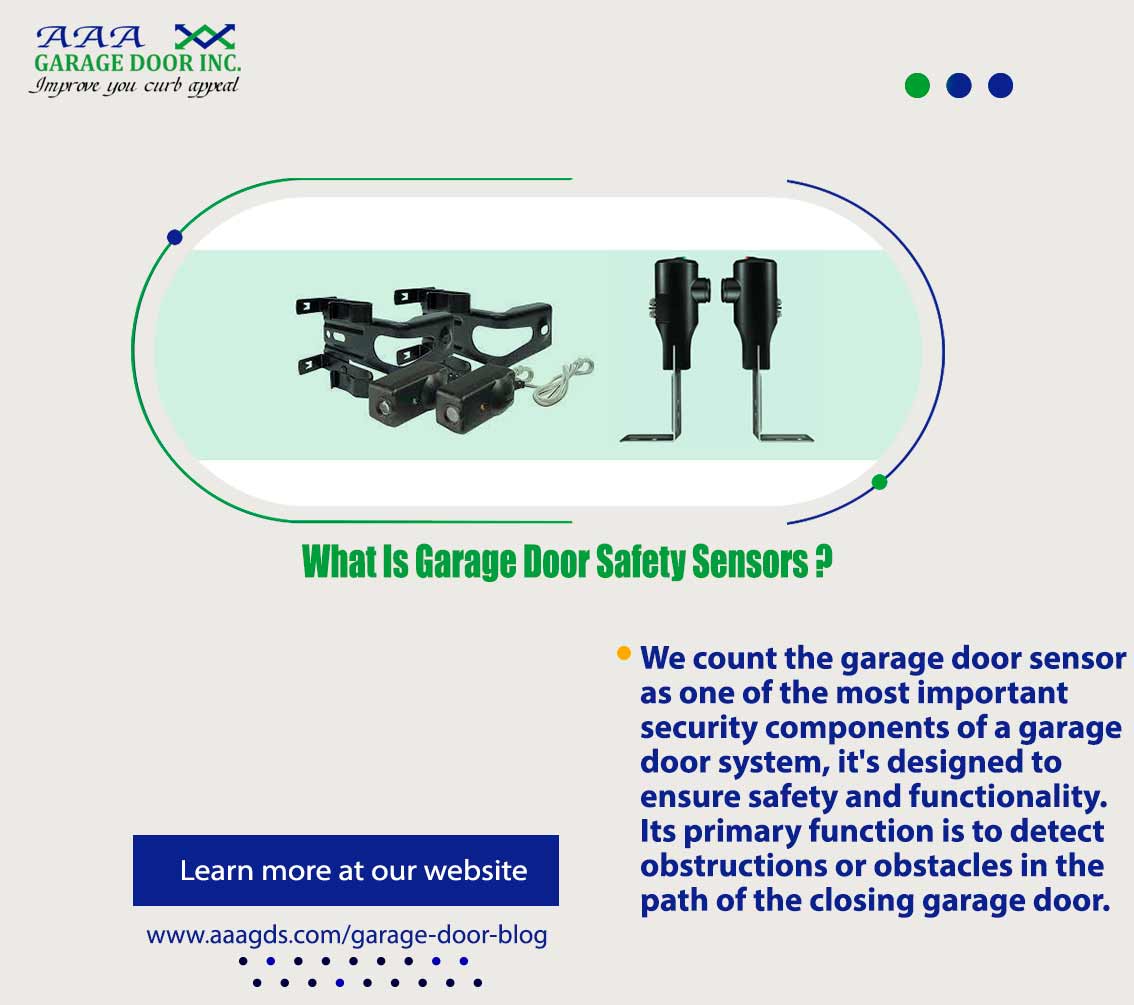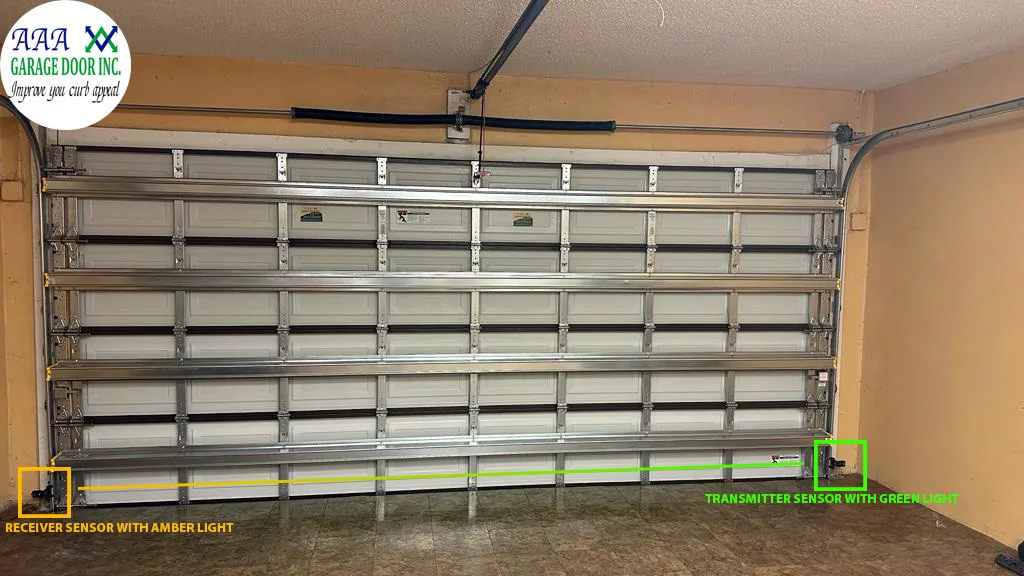We count garage door safety sensors as one of the most important security components of a garage door system, it’s designed to ensure safety and functionality. Its primary function is to detect obstructions or obstacles in the path of the closing garage door.
How Does The Garage Door Sensor Work?
Let’s explain this first in a simple form, the garage door sensor operates through the transmission and reception of infrared or laser beams. By detecting interruptions in the beam, it safeguards against accidents by prompting the door to reverse its movement, thus protecting both property and individuals.
Typically, a garage door sensor consists of two main parts: the transmitter and the receiver. These components are usually mounted on the sides of the garage door, near the bottom. The transmitter emits an infrared beam or laser across the doorway to the receiver, creating an invisible infrared line.
When the garage door is opening and closing, the receiver continuously monitors the infrared beam. If the beam remains unbroken, indicating that there are no obstructions, the garage door will continue its normal closing process. However, if the beam is interrupted or broken, it signifies the presence of an object in the door’s path, and the sensor triggers a safety mechanism.
Upon detection of an obstruction, the sensor immediately sends a signal to the garage door opener, instructing it to reverse the door’s movement. This prevents the door from closing on the object or person and avoids potential accidents or damages. The reversal mechanism can either stop the door’s movement entirely or prompt it to open back up, depending on the specific design of the garage door system.
In addition to the primary safety function, garage door sensors often have secondary features. Some models include a smart beam obstruction indicator, which alerts you with a notification sent to your phone if the sensor is interrupted, misaligned or the door reversed. This feature helps ensure the sensor functions correctly all the time and maintains optimal safety conditions to help monitor your door operations.
Where is the garage door safety sensor?
The garage door safety sensor is typically located near the bottom of the garage door tracks or at the wall beside the tracks, on both sides of the doorway.
To be more specific, according to Door & Access Systems Manufacturers Association (DASMA), garage door safety sensors should be installed no more than six inches above the floor. One sensor, known as the transmitter with green led light, is mounted on the right side of the door, while the other sensor, called the receiver with amber led light, is positioned on the left side.
Do you need safety sensors for the garage door?
Yes, garage door safety sensors are essential components for garage doors, and their installation is highly recommended for enhanced safety and accident prevention.
That being said, all states, including Florida, have recognized the importance of garage door safety sensors and have implemented regulations to ensure their use. The U.S. Federal Law UL 325 requires all garage doors to include safety mechanisms, such as garage door sensors and all
AAA Garage Door Inc. is Based in our beloved Sunshine Florida State so we know that Florida building codes have required residential garage doors equipped with garage door openers manufactured in and forward 1993 to have an approved safety system, which typically includes safety sensors. These safety sensors are required to be installed and functioning properly to comply with the regulations.
Ultimately, regardless of specific legal requirements, it is highly recommended to install safety sensors for garage doors as they significantly contribute to the overall safety of the system, preventing accidents and protecting both property and individuals.
How long do garage door safety sensors last?
Since our operation, we found that most of the time garage door sensors can last for 4 to 5 years of use, sometimes more than that which only requires repairs and not a total replacement.
Do I need to upgrade my garage door safety sensors?
Upon mistakes and learning from them, products get better and better in avoiding the mistakes or malfunctions that manufacturers know about it, and that maximizes your security so we recommend replacing your garage door sensor as soon as you find a newer version released because after each new version release but for affordability solutions sometimes it’s okay to stay with your current safety sensors.
How do you Install garage door sensors?
These are the simple steps you need to install your garage door safety sensors
- UNPLUG THE GARAGE DOOR OPENER
- LOCATE THE SENSOR MOUNTING BRACKETS
- POSITION THE MOUNTING BRACKETS
- ATTACH THE BRACKETS
- ATTACH THE SENSORS TO THE BRACKETS
- CONNECT THE WIRES
- TEST THE SAFETY SENSORS
- ADJUST THE SENSORS
For more detailed steps please read our article about installing garage door sensors.
Remember, these steps provide a general guideline, and it is crucial to refer to the specific instructions provided with your garage door sensor kit. Additionally, if you are unsure about any aspect of the installation process, it is always advisable to seek professional assistance from a garage door company.
Living in Miami-dade or Broward Counties Our qualified garage door technicians are always ready to help you just give us a call at 305-702-0113. AAA Garage Door Inc. Is ready to help you with your garage door sensors installation right away.
How do I test my garage door safety sensors?
- Clear the garage door area: Make sure the garage door area is free from any obstructions, objects, or debris that could interfere with the sensor’s operation.
- Check the sensor alignment: Visually inspect the sensors to ensure they are properly aligned. The transmitter and receiver units should face each other directly, and there should be no physical obstructions blocking the path between them. then make sure of these 2 points: Your Sensors Are Wired Correctly
Making sure of the wires is important before your first time testing your garage door sensors so make sure you followed the correct wiring instruction from your opener manual. If your sensors are correctly wired you will find that the sensors led lights is active and not blinking or has weak lights. Your Green Led Light Is Lighting Solid
If you see that the green led light is blinking that indicates that your transmitter unit is not probably aligned to the receiver unit. To align your garage door safety sensors correctly you need first to make sure your sensors are at the same height and six inches from the floor then move your receiver unit until you find your transmitter unit led lights - Close the garage door: Use the garage door opener or the control panel to activate the closing function of the garage door.
- Interrupt the sensor beam: As the garage door is in the process of closing, deliberately interrupt the sensor beam by placing an object, such as a cardboard box or a broomstick, between the sensors. Ensure that the object is positioned at the same height as the sensor beam.
- Observe the garage door’s response: If the safety sensors are functioning correctly, the garage door should immediately stop its downward movement and reverse its direction upon detecting the obstruction. You should hear the beeping sound after the garage door reverses completely.
- Remove the obstruction: Once you have confirmed that the sensors are working, remove the object that was blocking the sensor beam.
- Test the sensors again: Repeat the process by closing the garage door and placing an object in the sensor’s path. Verify that the door reverses its movement as expected.
- Clean the sensors: Over time, dust, dirt, or debris may accumulate on the sensors, affecting their performance. Regularly clean the sensors with a soft cloth to maintain their effectiveness.
Regularly testing your garage door safety sensors, ideally, once a month, helps ensure the continued safety of your garage door system. If you notice any issues or if the sensors do not function as expected during the testing process, it is recommended to consult our professional garage door technician for further inspection and maintenance.
Can garage door sensors be reversed?
Yes, you can reverse the garage door sensors to be the receiver sensor on the right side of the door and the transmitter sensor on the left side of the door but it’s not recommended except in rare For example but not limited like where the Receiving sensor is exposed to direct sunlight so the sunlight interferes with the infrared beam emitted to the transmitter sensors which causes the sensors to not function all the time probably.









0 Comments